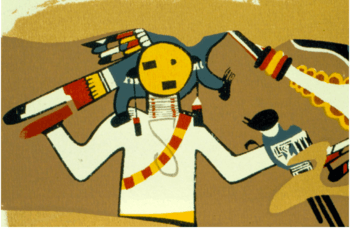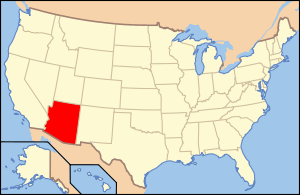Awatovi Ruins
|
Awatovi Ruins | |
|
Scene at the ruins in 1937 | |
  | |
| Location | Hopi Indian Reservation, Navajo County, Arizona, USA |
|---|---|
| Nearest city | Keams Canyon, Arizona |
| Coordinates | 35°43′7″N 110°16′37″W / 35.71861°N 110.27694°WCoordinates: 35°43′7″N 110°16′37″W / 35.71861°N 110.27694°W |
| Built | 1200 |
| NRHP Reference # | 66000187 |
| Significant dates | |
| Added to NRHP | October 15, 1966[1] |
| Designated NHL | July 19, 1964[2] |

Awatovi Ruins is a National Historic Landmark in Hopi Reservation, Arizona, United States, designated in 1964.[2] In 1540, Coronado's men visited this village. What remains are the ruins of a five-hundred-year-old pueblo. There are also ruins from a Spanish mission built in the 17th century. It is within the bounds of the Hopi Indian Reservation.
In the 1930s, Hopi artist Fred Kabotie was commissioned by the Peabody Museum to reproduce the prehistoric murals found during the excavation of the Awatovi Ruins.[3]
Pre-European History
Awatovi was founded sometime after 1300, according to ceramics recovered from the archaeological excavations of Awatovi. It quickly grew to be the largest and most important village within the Hopi area.[4] It housed members of the Bow Clan and was the largest of the villages on Antelope Mesa. There is some archaeological evidence to suggest that while modern Hopis claim ancestry with the Jeddito Phase sites, including Awatovi, these Jeddito villages may not have been Hopi.[5][6]
European Contact
Awatovi was the first of the Hopi villages to be visited and conquered by the Spanish. In the early 16th century AD, Awatovi was one of the largest and most important of the villages. It had already been in existence for about 450 years. The first European visitor, in 1540, was Pedro de Tovar, dispatched by Francisco Vásquez de Coronado to the Hopi villages a week after the capture of Hawikuh. A skirmish occurred when de Tovar arrived, but the inhabitants quickly sued for peace and offered presents of cloth, skins, turquoise, and maize. The five remaining Hopi pueblos then offered fealty to the King of Spain.[7]
The Spanish did not visit Hopi again until 1583, when the Antonio de Espejo expedition spent several days at the Hopi villages before turning southwest to the Verde Valley. Juan de Oñate, in 1598, found the Hopis ready to capitulate formally to the King of Spain. Oñate visited the pueblos again in 1605, and Captain Gerónimo Marquez in 1614, but not until 1629 did the Spanish make any substantial missionary effort among the Hopis.[7] This same year the Spanish friars built the mission of San Bernardo de Aguatubi over the main kiva at Awatovi, following the practice of "supremacy" where the church would be built over the most important site of the heathen religion.[8]
During the Pueblo Revolt, the Hopis razed the church at Awatovi and killed the priests operating at the other Hopi villages.[9] The Hopis expected reprisals for participating in the 1680 rebellion, but none came. When Diego de Vargas, the reconqueror, arrived in 1692, the Hopis apparently reswore their allegiance to Spain, and he departed without incident.[7][9] Not long afterward, the Spaniards rebuilt the mission of San Bernardo de Aguatubi.[9]
In 1700, tensions began to grow in the pueblo of Awatovi between the converted Hopis and traditionalists. By the end of 1700, the extreme hostility of most Hopis to Christian converts at Awatovi led to the destruction of the pueblo. The attackers killed all the men at Awatovi, and scattered the women and children among the other villages. The site was never reoccupied. [4][7]
History after Abandonment
Important early work at Awatovi was reported by Jesse Walter Fewkes in 1893-5. Extensive archeological excavations were conducted at Awatovi by J. O. Brew of the Peabody Museum in the 1930s. Brew's extensive artifact collections and archives are held at the Peabody Museum. Most of his excavations have been backfilled.[10]
References
- ↑ National Park Service (2007-01-23). "National Register Information System". National Register of Historic Places. National Park Service.
- 1 2 "Awatovi Ruins". National Historic Landmark summary listing. National Park Service. 2007-09-27.
- ↑ "Fred Kabotie biography". AskArt.
- 1 2 Malotki, Ekkehart. 2002. Hopi Tales of Destruction. Bison Books. pp. 230
- ↑ Hargrave, Lyndon. The Jeddito Valley and the First Pueblo Towns in Arizona to Be Visited By Europeans (Museum Notes, Museum of Northern Arizona, Volume 8, No. 4, October 1935)
- ↑ Parsons, Elise. 1936. Early Relations between Hopi and Keres. American Anthropologist, New Series, Vol. 38, No. 4. pp. 554-560
- 1 2 3 4 History of Awatovi. This section incorporates public domain text from this US government website.
- ↑ Watson Smith, Kiva Mural Decorations at Awatovi and Kawaika-a, with a Survey of Other Wall Paintings in the Pueblo Southwest, Papers of the Peabody Museum, 2006 reprint ISBN 978-0-87365-126-4
- 1 2 3 Roberts, David. 2005. The Pueblo Revolt; the secret rebellion that drove the Spaniards out of the Southwest. Simon and Schuster. pp. 288
- ↑ Awatovi Ruins NHL
Further reading
- Watson Smith, Kiva Mural Decorations at Awatovi and Kawaika-a, with a Survey of Other Wall Paintings in the Pueblo Southwest, Papers of the Peabody Museum, 2006 reprint ISBN 978-0-87365-126-4
- Hester A. Davis,Remembering Awatovi: The Story of an Archaeological Expedition in Northern Arizona, 1935-1939, Peabody Museum Monographs. 2008 reprint ISBN 978-0-87365-911-6
External links
- Awatovi Black-on-yellow Ladle at Arizona State Museum
- Hopi Nation Exemplary Arts: Section C — Subject: Ceremony— Ancient and Contemporary Images, photo gallery includes Awatovi mural images
- Watson Smith, Kiva Mural Decorations at Awatovi and Kawaika-a: With a Survey of Other Wall Paintings in the Pueblo Southwest, Papers of the Peabody Museum, hardcover 2006
- Hester A. Davis, Remembering Awatovi: The Story of an Archaeological Expedition in Northern Arizona, 1935-1939, Peabody Museum Monographs, paperback 2008



